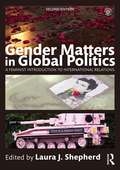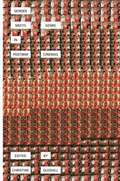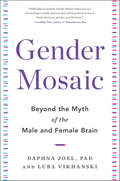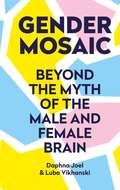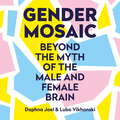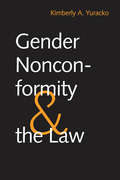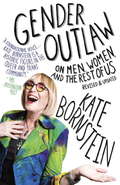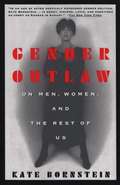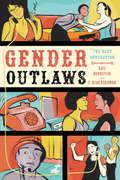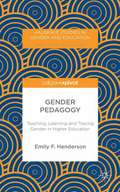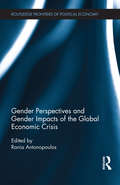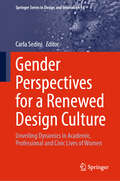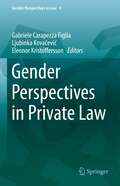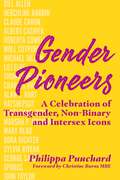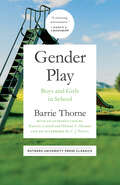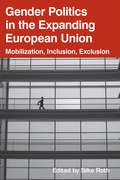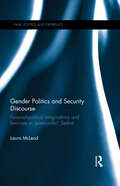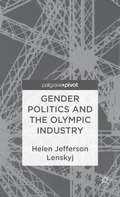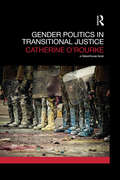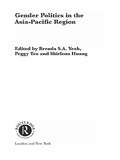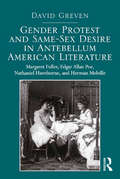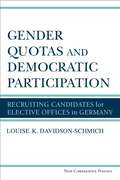- Table View
- List View
Gender Matters in Global Politics: A Feminist Introduction to International Relations
by Laura J. ShepherdFully revised and updated, this second edition of Gender Matters in Global Politics is a comprehensive textbook for advanced undergraduates studying feminism & international relations, gender and global politics and similar courses. It provides students with an accessible but in-depth account of the most significant theories, methodologies, debates and issues. This textbook is written by an international line-up of established and emerging scholars from a range of theoretical perspectives, and brings together cutting-edge feminist scholarship in a variety of issue areas. Key features and benefits of the book: Introduces students to the wide variety of feminist and gender theory and explains the relevance to contemporary global politics Explains the insights of feminist theory for a range of other disciplines including international relations, international political economy and security studies Addresses a large number of key contemporary issues such as human rights, trafficking, rape as a tool of war, peacekeeping and state-building, terrorism and environmental politics Features detailed pedagogical tools and resources - seminar exercises, text boxes, photographs, suggestions for further reading, web resources and a glossary of key terms New chapters on - Environmental politics and ecology; War; Terrorism and political violence; Land, food and water; International legal institutions; Peacebuilding institutions and post-conflict reconstruction; Citizenship; Art, aesthetics and emotionality; and New social media and global resistance. This text enables students to develop a sophisticated understanding of the work that gender does in policies and practices of global politics.
Gender Meets Genre in Postwar Cinemas
by Christine GledhillThis remarkable collection uses genre as a fresh way to analyze the issues of gender representation in film theory, film production, spectatorship, and the contexts of reception. With a uniquely global perspective, these essays examine the intersection of gender and genre in not only Hollywood films but also in independent, European, Indian, and Hong Kong cinemas. Working in the area of postcolonial cinema, contributors raise issues dealing with indigenous and global cinemas and argue that contemporary genres have shifted considerably as both notions of gender and forms of genre have changed. The volume addresses topics such as the history of feminist approaches to the study of genre in film, issues of female agency in postmodernity, changes taking place in supposedly male-dominated genres, concepts of genre and its use of gender in global cinema, and the relationship between gender and sexuality in film. Contributors are Ira Bhaskar, Steven Cohan, Luke Collins, Pam Cook, Lucy Fischer, Jane Gaines, Christine Gledhill, Derek Kane-Meddock, E. Ann Kaplan, Samiha Matin, Katie Model, E. Deidre Pribram, Vicente Rodriguez Ortega, Adam Segal, Chris Straayer, Yvonne Tasker, Deborah Thomas, and Xiangyang Chen.
Gender Mosaic: Beyond the Myth of the Male and Female Brain
by Luba Vikhanski Daphna Joel,With profound implications for our most foundational assumptions about gender, Gender Mosaic explains why there is no such thing as a male or female brain.For generations, we've been taught that women and men differ in profound and important ways. Women are more sensitive and emotional, whereas men are more aggressive and sexual, because this or that region in the brains of women is smaller or larger than in men, or because they have more or less of this or that hormone. This story seems to provide us with a neat biological explanation for much of what we encounter in day-to-day life. But is it true? According to neuroscientist Daphna Joel, it's not. And in Gender Mosaic, she sets forth a bold and compelling argument that debunks the notion of female and male brains. Drawing on the latest scientific evidence, including the groundbreaking results of her own studies, Dr. Joel explains that every human brain is a unique mixture -- or mosaic -- of "male" and "female" features, and that these mosaics don't map neatly into two categories. With urgent practical implications for the way we understand ourselves and the world around us, Gender Mosaic is a fascinating look at the science of gender, sex and the brain, and at how freeing ourselves from the gender binary can help us all reach our full human potential.
Gender Mosaic: Beyond the myth of the male and female brain
by Luba Vikhanski Prof. Daphna JoelThis timely manifesto calls for a future free from gender-based assumptions about human potential. Written by the internationally renowned neuroscientist whose game-changing research debunks the myth of male and female brains.For generations we've been taught that women and men differ in profound ways. Women are supposedly more sensitive and cooperative, whereas men are more aggressive and sexual because this or that region in the brains of women is larger or smaller than in the brains of men, or because they have more or less of this or that hormone. This story seems to provide us with a neat biological explanation for much of what we encounter in day-to-day life. It's even sometimes used to explain why, for example, most teachers are women and most engineers are men. But is it true? Using the ground-breaking results from her own lab and from other recent studies, neuroscientist Daphna Joel shows that it is not. Instead, argues Joel, every brain - and every human being - is a mosaic, or mixture, of 'female' and 'male' characteristics. With urgent practical implications for the world around us, this is a fascinating look at gender - how it works, its history and its future - and a sorely needed investigation into the false basis of our most fundamental beliefs. Perfect for readers of Mary Beard's Women & Power, Cordelia Fine's Testosterone Rex, Chimamanda Ngozi Adichie's We Should All Be Feminists and Gina Rippon's The Gendered Brain. 'Brilliantly accessible. Gender Mosaic takes you on a fascinating scientific journey that will transform how you think about sex, gender and the brain.' Cordelia Fine, author of Testosterone Rex'A power-packed manifesto that envisions what our world might look like if we let go of tired gender stereotypes.' - Sarah Richardson, author of Sex Itself 'Gender Mosaic is the book I've been waiting for! Enlightening, funny and never dogmatic, Joel plumbs the science, offering great insights into how moving beyond that stale story of the male and female brain could improve medicine, education, careers and relationships.' - Rebecca Jordan-Young, author of Brain Storm'Joel and Vikhanski offer a fascinating glimpse of what's possible when we liberate ourselves from the myth of pink and blue brains.' - Lise Eliot PhD, Professor of Neuroscience, Rosalind Franklin University of Medicine and Science'This is a fantastic book. It is one of the best books about sex, gender, biology, and the brain - and the social implications of these issues - that I have ever read. The writing is clear, captivating, and concise - and the content is groundbreaking. This is a visionary and brave book.' - Rebecca S. Bigler, Professor Emeritx of Psychology, University of Texas at Austin
Gender Mosaic: Beyond the myth of the male and female brain
by Luba Vikhanski Prof. Daphna JoelInfluential neuroscientist Professor Daphna Joel explains why there is no such thing as a male or female brain and no neural basis for differentiating people based on sex.This timely manifesto calls for a future free from gender-based assumptions about human potential. Written by the internationally renowned neuroscientist whose game-changing research debunks the myth of male and female brainsFor generations we've been taught that women and men differ in profound ways. Women are supposedly more sensitive and cooperative, whereas men are more aggressive and sexual, because this or that region in the brains of women is larger or smaller than in the brains of men, or because they have more or less of this or that hormone. This story seems to provide us with a neat biological explanation for much of what we encounter in day-to-day life. It's even sometimes used to explain, for example, why most teachers are women and most engineers are men. But is it true? Using the ground-breaking results from her own lab and from other recent studies, neuroscientist Daphna Joel shows that it is not. Instead, argues Joel, every brain - and every human being - is a mosaic, or mixture, of 'male' and 'female' characteristics. With urgent practical implications for the world around us, this is a fascinating look at gender - how it works, its history and its future - and a sorely needed investigation into the false basis of our most fundamental beliefs. Perfect for readers of Mary Beard's Women & Power, Cordelia Fine's Testosterone Rex, Chimamanda Ngozi Adichie's We Should All Be Feminists and Gina Rippon's The Gendered Brain. 'Brilliantly accessible. Gender Mosaic takes you on a fascinating scientific journey that will transform how you think about sex, gender and the brain.' Cordelia Fine, author of Testosterone Rex (p) 2019 Octopus Publishing Group
Gender Nonconformity and the Law
by Kimberly A. YurackoWhen the Civil Rights Act of 1964 was passed, its primary target was the outright exclusion of women from particular jobs. Over time, the Act's scope of protection has expanded to prevent not only discrimination based on sex but also discrimination based on expression of gender identity. Kimberly Yuracko uses specific court decisions to identify the varied principles that underlie this expansion. Filling a significant gap in law literature, this timely book clarifies an issue of increasing concern to scholars interested in gender issues and the law.
Gender Outlaw: On Men, Women and the Rest of Us
by Kate BornsteinPart coming-of-age story, part mind-altering manifesto on gender and sexuality, coming directly to you from the life experiences of a transgender woman, Gender Outlaw breaks all the rules and leaves the reader forever changed.26 black-and-white illustrations.
Gender Outlaw: On Men, Women and the Rest of Us
by Kate Bornstein"I know I'm not a man . . . and I've come to the conclusion that I'm probably not a woman, either. . . . . The trouble is, we're living in a world that insists we be one or the other." With these words, Kate Bornstein ushers readers on a funny, fearless, and wonderfully scenic journey across the terrains of gender and identity. On one level, Gender Outlaw details Bornstein's transformation from heterosexual male to lesbian woman, from a one-time IBM salesperson to a playwright and performance artist. But this particular coming-of-age story is also a provocative investigation into our notions of male and female, from a self-described nonbinary transfeminine diesel femme dyke who never stops questioning our cultural assumptions.Gender Outlaw was decades ahead of its time when it was first published in 1994. Now, some twenty-odd years later, this book stands as both a classic and a still-revolutionary work--one that continues to push us gently but profoundly to the furthest borders of the gender frontier.From the Trade Paperback edition.
Gender Outlaw: On Men, Women, and the Rest of Us
by Kate BornsteinKate Bornstein's book was first published in 1994, with two hardback printings. Then it was republished in paperback in 1995 with an afterward. Ms. Bornstein's script for her first theatre piece: Hidden: A Gender, is included in the book in script form. Basic questions about gender, roles, feminism, transsexuality, male-to-female surgery are covered. The book was considered a landmark piece when first published.
Gender Outlaws: The Next Generation
by Kate Bornstein S. Bear BergmanIn the 15 years since the release of Gender Outlaw, Kate Bornstein's groundbreaking challenge to gender ideology, transgender narratives have made their way from the margins to the mainstream and back again. Today's transgenders and other sex/gender radicals are writing a drastically new world into being. In Gender Outlaws, Bornstein, together with writer, raconteur, and theater artist S. Bear Bergman, collects and contextualizes the work of this generation's trans and genderqueer forward thinkers--new voices from the stage, on the streets, in the workplace, in the bedroom, and on the pages and websites of the world's most respected mainstream news sources. Gender Outlaws includes essays, commentary, comic art, and conversations from a diverse group of trans-spectrum people who live and believe in barrier-breaking lives.
Gender Pay Gap und Geschlechter (Jahrbuch geschlechterbezogene Hochschulforschung)
by Beate Kortendiek Lisa Mense Sandra Beaufaÿs Jenny Bünnig Ulla Hendrix Jeremia Herrmann Heike Mauer Jennifer NiegelIm „Jahrbuch geschlechterbezogene Hochschulforschung“ werden regelmäßig Forschungsergebnisse zur Geschlechter(un)gleichheit an nordrheinwestfälischen Hochschulen veröffentlicht. Diese basieren auf detaillierten Analysen hochschulstatistischer bundes- und landesweiter Daten im Quer- und Längsschnitt. Zudem wird erforscht, welche Gleichstellungspraktiken an den Hochschulen mit jeweils aktuellen Schwerpunktsetzungen ein- und umgesetzt werden.In diesem Band steht der Gender Pay Gap in Hochschule und Wissenschaft im Fokus. In der Wissenschaft wird davon ausgegangen, dass sich Leistung an sachlichen Kriterien messen lässt und dass das Geschlecht der Forschenden und Lehrenden keinen Einfluss auf Leistung und Exzellenz hat. Die Ergebnisse zum Gender Pay Gap auf Professurebene berühren daher gleich zwei empfindliche Tabus. Der erste Tabubruch besteht darin, dass die Geschlechtsneutralität der Wissenschaft hinterfragt wird. Der zweite Tabubruch wird mit dem Sprechen über Geld begangen.
Gender Pedagogy: Teaching, Learning and Tracing Gender in Higher Education
by Emily F. HendersonWhen addressed in its full reactive potential, gender has a tendency to unfix the reassuring certainties of education and academia. Gender pedagogy unfolds as an account of teaching gender learning that is rooted in Derrida's concept of the 'trace', reflecting the unfixing properties of gender and even shaking up academic knowledge production.
Gender Perspectives and Gender Impacts of the Global Economic Crisis (Routledge Frontiers of Political Economy #180)
by Rania AntonopoulosWith the full effects of the Great Recession still unfolding, this collection of essays analyses the gendered economic impacts of the crisis. The volume, from an international set of contributors, argues that gender-differentiated economic roles and responsibilities within households and markets can potentially influence the ways in which men and women are affected in times of economic crisis. Looking at the economy through a gender lens, the contributors investigate the antecedents and consequences of the ongoing crisis as well as the recovery policies adopted in selected countries. There are case studies devoted to Latin America, transition economies, China, India, South Africa, Turkey, and the USA. Topics examined include unemployment, the job-creation potential of fiscal expansion, the behavioral response of individuals whose households have experienced loss of income, social protection initiatives, food security and the environment, shedding of jobs in export-led sectors, and lessons learned thus far. From these timely contributions, students, scholars, and policymakers are certain to better understand the theoretical and empirical linkages between gender equality and macroeconomic policy in times of crisis.
Gender Perspectives for a Renewed Design Culture: Unveiling Dynamics in Academic, Professional and Civic Lives of Women (Springer Series in Design and Innovation #54)
by Carla SediniThis book explores the evolving role of women in scientific, professional, and public spheres, with a special focus on design, not only as a field but also as a strategic tool for societal change. The first section examines Gender and Science, addressing the promotion of gender-inclusive cultures within academia. Contributions from scholars across disciplines delve into how gender roles shape academic careers, influencing choices and opportunities for success. The second section shifts to professional practice, bringing together designers and practitioners to reflect on the changing landscape of the design industry. It investigates the presence and achievements of women in design and how the field itself can become a catalyst for reducing gender disparities through inclusive approaches to objects, spaces, and services. The third section broadens the scope to urban contexts, discussing the right to the city from a gendered perspective. It highlights the importance of designing urban environments that foster safety, accessibility, and social equity, ensuring women&’s and other genders' needs and experiences are embedded in the fabric of public spaces and lives. A valuable resource for researchers, professionals, and students in design, social sciences, and gender studies, this book offers critical insights into the shifting dynamics of gender in academic, professional, and civic life, challenging norms and envisioning a more inclusive future.
Gender Perspectives in Private Law (Gender Perspectives in Law #4)
by Eleonor Kristoffersson Gabriele Carapezza Figlia Ljubinka KovačevićThis book discusses prominent and controversial gender-related issues across the fields of family law, tort law, labour law, civil procedure law, ADR and private international law. An important critical assumption made by the authors is that the gender equality perspective has been largely neglected in several branches of private law, since scholars researching the intersection between gender and legal studies are mostly focused on public law and human rights law. In light of that, the book contributes not only to the deconstruction of gender-blind private law, but also to the development of a gender-competent analysis of the key branches of private law, starting with private international law. Gender perspective in family law is analyzed on the basis of gendered and heteronormative operations of family law with reference to the formation of legally recognized relationships, the establishment of legal parenthood, the division of marital property after a divorce, and the arrangements for post-separation parenting. Also, regulation of family matters in Indian society and the gender equality perspective from the principle of the child’s best interest are considered. As far as tort law is concerned, the book addresses compensation for damages suffered by women performing unpaid household work. Further, it contains papers dedicated to the following labour law issues: the genesis of labor law and its capacity to contribute either to worsening gender inequality in the world of work or to promoting gender equality; gender segregation in the labour market and its connection to family-friendly policies in the European Union; sexual harassment at work; and the impact of work digitalization on gender-related labour law issues. Lastly, the authors analyze gender equality in civil procedural law, as well as in mediation as a tool for encouraging the peaceful settlement of disputes. The book is intended to improve awareness of the wide range of private law issues that are important for understanding the ways in which gender inequality shapes everyday experiences, while also presenting critical considerations of the key private law instruments for achieving gender equality.
Gender Pioneers: A Celebration of Transgender, Non-Binary and Intersex Icons
by Philippa Punchard'A vital book' JUNO ROCHE'Beautifully illustrated and fascinating' MEG-JOHN BARKER'Fun and fact-filled' SUSAN STRYKERThis inspiring collection of illustrated portraits celebrates the lives of influential transgender, non-binary and intersex figures throughout history.Showcasing the diversity of gender identities and expressions that have existed in all cultures alongside developments from recent years, the extraordinary stories in this book highlight the achievements and legacies of those who have fought to be themselves, whatever their gender. From activists, soldiers and historical leaders through to pirates, actors and artists, this book explores the life and times of over fifty trans and intersex trailblazers in their fight for equality, acceptance and change. Poignant, educational and empowering, these are the gender pioneers everyone needs to know about.
Gender Play: Boys and Girls in School (Suny Series On Sport, Culture, And Social Relations Ser.)
by Barrie ThorneWhen it first appeared in 1993, Barrie Thorne’s Gender Play: Girls and Boys in School became an instant classic in the budding fields of feminist sociology and childhood studies. Through detailed first-hand observations of fourth and fifth graders at play, she investigated questions like: Why do girls and boys tend to self-segregate in the schoolyard? What can playful teasing and ritualized games like “cooties” and “chase and kiss” teach us about how children perform gendered identities? And how do children articulate their own conceptions of gender, distinct from those proscribed by the adult world? A detailed and perceptive ethnography told with compassion and humor, Gender Play immerses readers in the everyday lives of a group of working-class children to examine the social interactions that shape their gender identities. This new Rutgers Classic edition of Gender Play contains an introduction from leading sociologists of gender Michael A. Messner and Raewyn Connell that places Thorne’s innovative research in historical context. It also includes a new afterword by one of Thorne’s own students, acclaimed sociologist C.J. Pascoe, reflecting on both the lasting influence of Thorne’s work and the ways that American children’s understandings of gender have shifted in the past thirty years.
Gender Politics In The Expanding European Union: Mobilization, Inclusion, Exclusion
by Silke RothIn May 2004, after bringing their legislation into accordance with EU regulations, ten more countries joined the European Union. The contributors to this volume assess the impact of this historical development on gender relations in the new and old EU member states. Instead of focusing on either western or eastern Europe, this book investigates the similarities and differences in diverse parts of Europe. Although initially limited, gender equality was part of the original framework of the European Union, an organization often more open than national governments to feminist demands, as this volume illustrates with case studies from eastern and western Europe. The enlargement process thus provides some important policy instruments for increasing equality between men and women.
Gender Politics and Mass Dictatorship
by Karen Petrone Jie-Hyun LimUsing mass dictatorship as a working hypothesis to comprehend support for dictatorship from below, this book concentrates on the gender politics deployed by dictatorial regimes such as Nazism, Stalinism, 'really existing socialism' in the GDR and People's Poland, Maoist China, the development dictatorship in South Korea, and colonial empires. 20th century dictatorial regimes used gender politics as a lever to mobilize men and women as voluntary participants in state projects. Ironically enough, women under dictatorships could become important players in the previously male-dominated public sphere in exchange for voluntary mobilization. But both men and women were not passive objects of gender politics. Men both embraced and rejected the masculine roles set out for them; and the dictatorial regimes' invitation to participate in the public sphere, designed for the self-mobilization of women, was often used by women for self-empowerment. This book shows the twisted paths of citizens' lives under the dictatorial regimes as they veered between self-mobilization and self-empowerment.
Gender Politics and Security Discourse: Personal-Political Imaginations and Feminism in 'Post-conflict' Serbia (War, Politics and Experience)
by Laura McLeodThis book investigates competing modes of thought about gender security and aims to understand the policy implications of personal-political imaginations. The work draws upon extensive research conducted by the author in Serbia to develop a comprehensive picture of how feminist and women’s organising relates to the broader national and international contexts surrounding gender security. Through an innovative analytical framework of personal-political imaginations, the book explores the role that memories, perceptions and hopes about conflict and post-conflict have upon the logics of gender security. It investigates how contrasting and competing modes of thought about ‘gender security’ are made, paying attention to how the dynamics of gender politics in Serbia shape the security discourse and narratives of activists. The volume explores in detail how feminist and women’s organisations have responded to UNSCR 1325 by analysing two policy debates and campaigns that seek to ‘achieve’ its goals and gender security in Serbia: (1) feminist antimilitarism and (2) connecting domestic violence to the abuse of small arms and light weapons. Ultimately, the book argues that the configuration of gender security discourse is intimately linked to personal-political imaginations of conflict and post-conflict. This book will be of much interest to students of gender politics, conflict studies, critical security studies, European politics and IR in general.
Gender Politics and the Olympic Industry
by Helen Jefferson LenskyjThis book explores how the Olympic industry has shaped hegemonic concepts of sporting masculinities and femininities for its own profit and image-making ends, examining its continuing marginalization of athletes on account of their race, ethnicity, gender, sexuality and class.
Gender Politics in Transitional Justice
by Catherine O'RourkeWhat role do transitional justice processes play in determining the gender outcomes of transitions from conflict and authoritarianism? What is the impact of transitional justice processes on the human rights of women in states emerging from political violence? Gender Politics in Transitional Justice argues that human rights outcomes for women are determined in the space between international law and local gender politics. The book draws on feminist political science to reveal the key gender dynamics that shape the strategies of local women’s movements in their engagement with transitional justice, and the ultimate success of those strategies, termed ‘the local fit’. Also drawing on feminist doctrinal scholarship in international law, ‘the international frame’ examines the role of international law in defining harms against women in transitional justice and in determining the ‘from’ and ‘to’ of transitions from conflict and authoritarianism. This book locates evolving state practice in gender and transitional justice over the past two decades within the context of the enhanced protection of women’s human rights under international law. Relying on original empirical and legal research in Chile, Northern Ireland and Colombia, the book speaks more broadly to the study of gender politics and international law in transitional justice.
Gender Politics in the Asia-Pacific Region (Routledge International Studies of Women and Place #No.3)
by Brenda S.A. Yeoh Peggy Teo Shirlena HuangAmidst the unevenness and unpredictability of change in the Asia-Pacific region, women's lives are being transformed. This volume takes up the challenge of exploring the ways in which women are active players, collaborators, participants, leaders and resistors in the politics of change in the region. The editors focus attention on the politics of gender as a mobilizing centre for identities, and the ways in which individualized identity politics may be linked to larger collective emancipatory projects based on shared interests, practical needs, or common threats. Collectively, the chapters illustrate the complexity of women's strategies, the diversity of sites for action, and the flexibility of their alliances as they carve out niches for themselves in what are still largely patriarchal worlds. This book will be of vital interest to scholars in a range of subjects, including gender studies, human geography, women's studies, Asian studies, sociology and anthropology.
Gender Protest and Same-Sex Desire in Antebellum American Literature: Margaret Fuller, Edgar Allan Poe, Nathaniel Hawthorne, and Herman Melville
by David GrevenExpanding our understanding of the possibilities and challenges inherent in the expression of same-sex desire before the Civil War, David Greven identifies a pattern of what he calls ’gender protest’ and sexual possibility recurring in antebellum works. He suggests that major authors such as Margaret Fuller, Edgar Allan Poe, Herman Melville, and Nathaniel Hawthorne consciously sought to represent same-sex desire in their writings. Focusing especially on conceptions of the melancholia of gender identification and shame, Greven argues that same-sex desire was inextricably enmeshed in scenes of gender-role strain, as exemplified in the extent to which The Narrative of Arthur Gordon Pym depicts masculine identity adrift and in disarray. Greven finds similarly compelling representations of gender protest in Fuller’s exploration of the crisis of gendered identity in Summer on the Lakes, in Melville’s representation of Redburn’s experience of gender nonconformity, and in Hawthorne’s complicated delineation of desire in The Scarlet Letter. As Greven shows, antebellum authors not only took up the taboo subjects of same-sex desire and female sexuality, but were adept in their use of a variety of rhetorical means for expressing the inexpressible.
Gender Quotas and Democratic Participation
by Louise K. Davidson-SchmichSince the 1970s, quotas for female political candidates in elections have proliferated worldwide. Beyond increasing the numbers of women in high-level elected bodies and, thereby, women's political representation, advocates claim that quotas foster gender-equal participation in democracy and create female role models. According to this reasoning, quotas also overcome barriers to women's political participation, especially discriminatory practices in the selection of electoral candidates. Though such claims have persuaded policymakers to adopt quotas, little empirical evidence exists to verify their effects. In Gender Quotas and Democratic Participation, Louise K. Davidson-Schmich employs a pathbreaking research design to assess the effects of gender quotas on all phases of political recruitment. Drawing on interviews with, and an original survey of, potential candidates in Germany, she investigates the extent to which quotas and corresponding increases in women's descriptive representation have resulted in similar percentages of men and women joining political parties, aspiring to elected office, pursuing ballot nominations, and securing selection as candidates. She also examines the effect of quotas on discriminatory selection procedures. Ultimately, Davidson-Schmich argues, quotas' intended benefits have been only partially realized. Quotas give women greater presence in powerful elected bodies not by encouraging female citizens to pursue political office at rates similar to men's, but by improving the odds that the limited number of politically ambitious women who do join parties will be elected. She concludes with concrete, original policy recommendations for increasing women's political participation. Book jacket.
